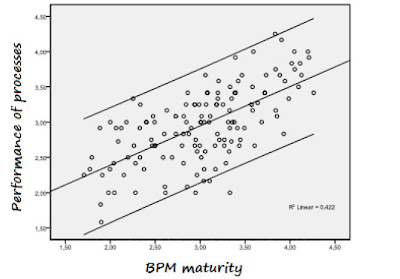General
We recently concluded a research into BPM, together with the University Utrecht.
Key facts: Focus on The Netherlands, web based Survey, 168 participants, statistically healthy, and from all major companies and organizations in The Netherlands (Private and Public sector).
One of the interesting findings
We asked various questions on the adoption of BPM practices (such as identifying processes, documenting them, assigning ownership, implementing plan-do-check-act, etc.). In addition we asked them about the satisfaction on process performance (cycle time, cost, quality, etc).
We calculated averages and found the following (in diagram):
 We found a positive correlation (and yes, we did check all the statistics).
We found a positive correlation (and yes, we did check all the statistics). I would say: a first statistical finding that shows that BPM actually can help.
Interestingly, when you look at the point-cloud, you see a small top-performing group (high process performance) with average high BPM maturity. And a group with low performance satisfaction, that varies in BPM maturity.
We performed research to find out if there were significant BPM maturity factors in the top-performers, in comparison to the lowest performers. We found significant factors - the key one being "management has an active role in the improvement of processes".
Interested in more findings? Such as the 7 key trends in BPM adoption? The 10 critical barriers? The most used BPM technology in The Netherlands? The Dutch survey results can be found on http://bit.ly/jttlwv.
An english summary is available (mail Roeland dot Loggen at Capgemini dot com or twitter me - Roeland).
No comments:
Post a Comment